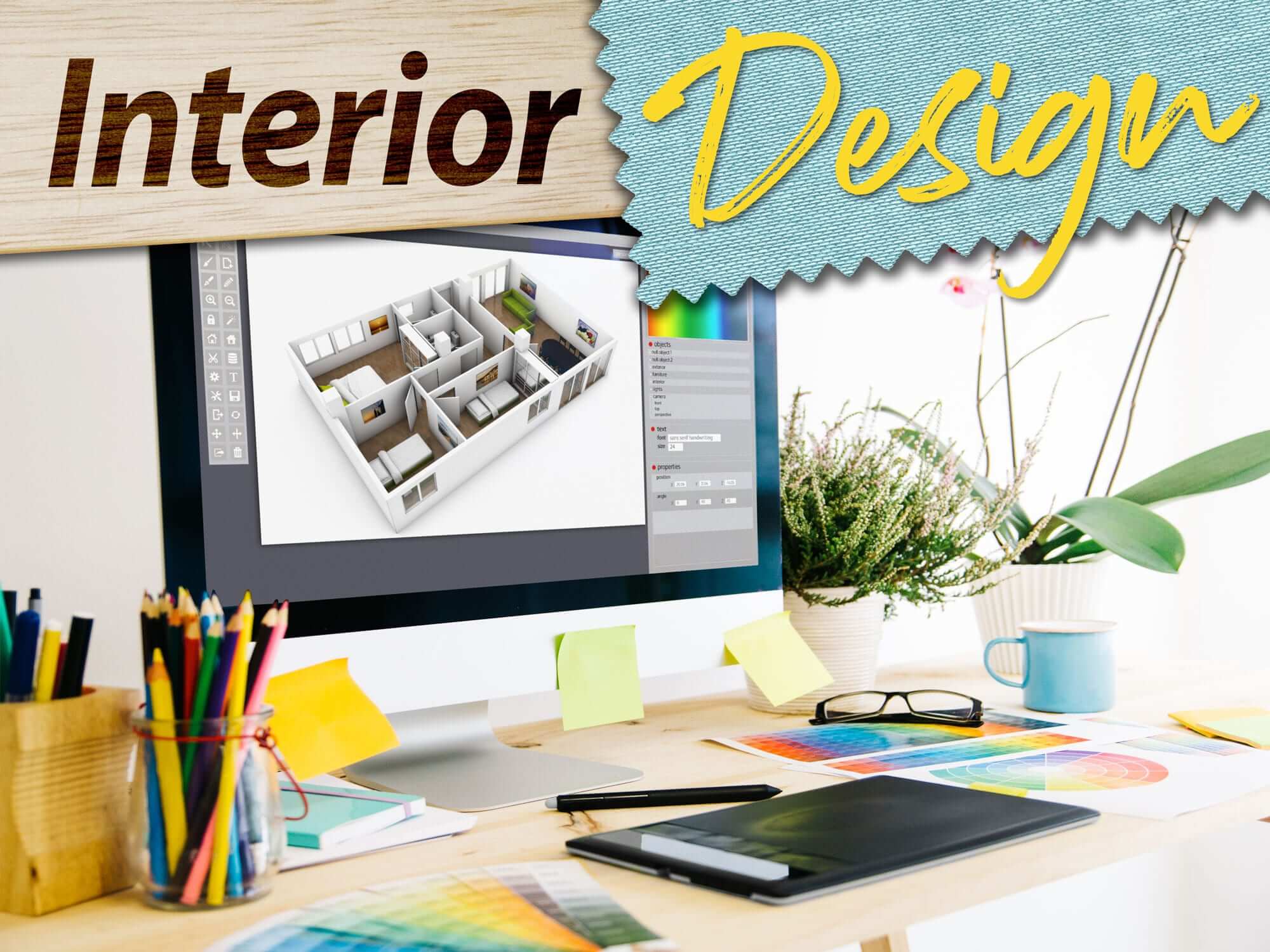
Interior Design
Do you have a flair for designing and decorating? If so, then let’s learn how to turn your interests and skills into a career. Explore color, texture, trends, and styles over time, how homes are built, and “green” options for homes and businesses. Interior designers do it all—from planning the color scheme to choosing furniture and light fixtures—with the end goal of creating a space where people can live or work comfortably, safely, and happily.
Units at a Glance
Unit 1: Introducing: Interior Design Careers
Have you always had a flare for designing? Do you love to decorate? If so, there are several ways for you to turn your interests and skills into a career. While staying on top of trends is an important part of interior design careers, there is a lot more to it than that. You’re not simply selecting the couch cushion that pulls together a room or picking out exactly the right paint color. While these talents help, most careers in interior design require great communication skills as well as a strong sense of style. Once you get the hang of communicating with your client, you will be sure to provide them with a look that is just what they were picturing!
What will you learn in this unit?
- Describe careers in the interior design industry
- Identify personal skills and interests as they relate to interior design careers
- Explore possible career paths in the interior design industry
- Research and present information on interior design careers, including the responsibilities, employment opportunities, and education/training requirements
Unit 2: Design and Communicate: Basic Skills for the Design Industry
What makes a good design? How do designers use color to evoke feelings or create mood? Even though designers each have a sense of style that guides them, there are also general principles to follow. Let’s consider more about these principles of design and how designers use them to create the look they want. We will also be discussing good communication techniques and what to do if you find yourself in a conflict with a client.
What will you learn in this unit?
- Define and illustrate the elements and principles of design
- Create a color wheel and describe the psychology behind different colors
- Distinguish between non-assertive, assertive, and aggressive communication
- Demonstrate communication skills that promote positive relationships in the workplace
- Practice active-listening and conflict-resolution skills
Unit 3: Tools of the Trade
How can you use color to convey feeling or mood? What’s the best way to allow your clients to envision the final product of a design or remodel? How will you sketch your ideas? These are just a few of the questions we will explore. You will learn about the tools required to begin a career in the interior design industry and the origins of the various types of fabric interior designers use. This is all important information. Yes, interior designers must have an eye for design, but without an understanding of the tools of the trade they can’t get very far!
What will you learn in this unit?
- Identify and select the appropriate tools and equipment for design projects
- Practice care and maintenance of design equipment
- Explore a variety of fabrics and consider uses of texture and color
- Use computer aided design to create and modify design plans
- Describe common types of plans created by designers
Unit 4: Types of Houses and Buildings
Have you ever wondered what is under the carpet in your living room? You’ll discover the steps used to create almost every home in America thanks to the uniform building codes. And you will get to take a peek at a cross-section of a typical home to see where everything goes! We will also take a look at how homes have changed over the decades and what types of things people should consider when choosing their ideal home.
What will you learn in this unit?
- Describe the steps taken to build a typical house
- Analyze the impact of society and the economy on housing changes through the decades
- Explain the process to determine housing needs and wants
- Evaluate the impact of climate and resources on housing choices
Unit 5: Basics of Decorating
Interior designers need to understand the basics of furniture and design styles, as well as how to choose furniture for a room by considering scale, function, and placement. Designers will be asked to advise clients on light fixtures, accessories, and appliances. And they need to be able to explain the best choices for the client. This is just some of the information that you will learn about here. Soon you’ll be confident in your ability to discuss design styles and furniture plans with all types of client for all kind of projects.
What will you learn in this unit?
- Identify the characteristics of furnishing and design styles
- Describe factors that impact interior design choices
- Discuss the pros and cons of décor and furnishing options
- Explain how to furnish a room taking into account factors such as scale, placement, and use
Unit 6: Trends in Interior Design
It’s most likely that you have heard about the movement to ‘go green’. The interior design industry is also working to be part of this movement. What makes a design green? And why should a designer spend time considering the environmental cost of their recommendations? Let’s find out by taking a look at the history of green design, some popular green design trends, and a famous green design house. We will even try to predict the future. What might design careers and trends look like in 50 years? Let’s just say, “I dream of drones carrying beautifully wrapped sofas.”
What will you learn in this unit?
- Analyze design trends to make evidence-based predictions about the future of design
- Discuss green design and the techniques, materials, and technology that can be applied to increase the sustainability of a project
- Evaluate the importance of green design and eco-friendly products
- Examine the positive and negative impact that a given design product has on the environment
Unit 7: Putting it Together: Designing Your Space
You’ve studied the principles of design and can explain the hallmarks of style in detail, but what about actually applying these skills to the design of a room? In this unit, we’ll go through the process of designing a room for a client, from the initial consultation all the way to placing accessories on end tables. You’ll learn how to propose designs to clients, order furnishings, and read the fine print on return policies. And because making your clients happy is a big part of the job, you will also learn to work with others and synthesize all the information that your clients give you to produce an aesthetically pleasing design that meets their requirements.
What will you learn in this unit?
- Work cooperatively with a client to achieve group goals
- Take leadership over a design project and demonstrate organizational responsibilities
- Apply math, reading, and critical thinking skills as they relate to the design industry
- Describe the steps required to create a functional design, taking into account a variety of aspects including the client’s needs, effective use of space, placement of furnishings, and aesthetics
Unit 8: Look to the Future: Your Career
Now that you have learned about the basics of the interior design industry, it is time to examine career prospects in the field and identify the steps to getting a job, including how to communicate and present yourself professionally. While your design skills and creativity are important, employers also look for employees with a good work ethic. You will learn about expectations in the working world, interview skills, and how to create an eye-catching portfolio.
What will you learn in this unit?
- Create and collect documents required to apply for a job
- Describe acceptable work habits and professionalism for the work place
- Identify and track possible career paths in the interior design field
- Discuss the qualities of an entrepreneur and the considerations required to start a business
- Identify the impacts of social media and the internet on interior design careers
Required Materials
Physical
- video recording device
- paper and/or index cards
- journal
- graph paper
- pen or pencil
- crayons, markers, or colored pencils (at least 12 colors)
- measuring tape
- printer and printer paper
- crafting supplies
- magazines, newspapers, or a computer with internet access to select furnishing items
Software
- word processing software
- CAD software (free download)
- spreadsheet software
- presentation software
- online virtual decoration software
Other
- some furnishing and décor items currently in your home
- an object to upcycle
- magazines, newspapers, fabric samples, and other items to include on a mood board
- friend or family member to act as an interviewer
- appropriate clothing for an interview role play



